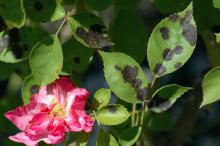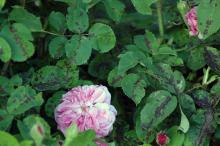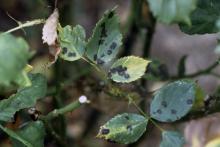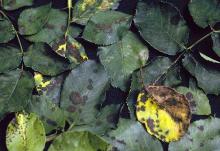See:
Cause Diplocarpon rosae, is a fungus that overwinters, or survives the cold season, on living or dead plant tissue that was infected in the previous growing season. Newly emerging leaves are most susceptible to this fungus. Spores produced on the old plant material are splashed on young plant tissue by winter and spring rains or by summer watering. After conidia land on a leaf, it takes at least 9 hours of leaf wetness for the spore to infect. In the Pacific Northwest, this moisture requirement is frequently and easily met.
Once the fungus is established in plant tissues, fungal fruiting bodies (acervuli) form in the spots in 11 to 30 days. A new crop of spores is produced and spreads to healthy portions of the plant. The cycle of infection is ready to begin again within 10 to 18 days. Conditions for growth and spread of the black spot fungus are most likely in spring and fall. However, rainy periods in any season encourage black spot, as long as the temperatures are between 50°F and 80°F.
Leaves infected with black spot produce the plant hormone ethylene. In leaves, high ethylene content leads to leaf drop. As a result, rose plants infected with black spot are defoliated early and look bare. Leaves may drop after only one or two lesions. Dropped leaves around the base of the plant then serve as a reservoir of fungal spores, reinfecting the plant during subsequent rains. Repeated defoliation leads to low vigor, inferior blooms, and high susceptibility to winter injury.
The natural genetic variability of the fungus means roses found resistant in one location may be susceptible in another location due to the presence of different fungal strains. Also, resistant roses may become susceptible after a few years due to changes in the local fungal population.
Symptoms Circular black spots, frequently with fringed (diffuse or feathery) margins, on the leaf. Yellowing and defoliation are common in susceptible cultivars. Bare stems with few leaves attached near the top is a frequent symptom. In wet weather, spots may become very severe and coalesce to make large irregular spots covering a third of the leaf surface. In cases of severe infections, similar appearing lesions also form on the stems. May be confused with other fungal leaf spotting diseases.
Cultural control
- Plant cultivars known to be resistant in your area. Note that the cultivar Carefree Spirit was the first landscape shrub to survive for 2 years in AARS tests without any fungicide and voted a winner.
- Avoid dense plantings and shaded areas.
- Avoid overhead watering that keeps plants wet for extended period of time.
- Rake up and burn all leaves in a rose planting at season's end.
- Prune canes back to two buds if canes are infected. Remove and destroy diseased canes before bud break.
Chemical control Focus applications at the beginning of the season starting at bud break. Apply frequently in wet spring weather and occasionally in summer (1- to 2-week intervals). May be very difficult to manage once the disease gets started. Almost every fungicide on the market is registered for this disease on this crop but only one or two materials are needed at any one time. Alternate or tank-mix materials with different modes of action to prevent developing resistant fungal populations. Some materials such as the Group 11 fungicides will not allow more than two (2) sequential applications. Organic materials have not been as effective as conventional products.
Research in Alabama indicates that monthly dormant-season applications of Group 3 fungicides may help reduce or delay onset of this disease.
Products available in home packaging:
- BioAdvanced Disease Control at 0.75 fl oz/gal water. Group 3 fungicide. H
- Bonide Captan 50 WP at 2 Tbsp/gal water can be used in home gardens. Washington only. Group M4 fungicide. H
- Bonide Fung-onil Multi-purpose Fungicide at 2.25 teaspoons/gal water. Group M5 fungicide. H
- Bonide Copper Fungicide at 8 oz/3 gal water. Group M1 fungicide. H
- Ferti-lome Liquid Systemic Fungicide II at 1 fl oz/gal water plus another fungicide. Group 3 fungicide. H
- Infuse Systemic Disease Control at 2 Tbsp/gal water plus another fungicide. Group 3 fungicides. H
- Monterey Liqui-Cop at 3 Tbsp/gal water. May discolor blooms. Group M1 fungicide. Group M1 fungicide. H
- Ortho MAX Garden Disease Control at 1.5 Tbsp/4 gal water. Group M5 fungicide. H
- Ortho Rose & Flower Disease Control at 2 fl oz/gal water. Group 3 fungicide. H
- Spectracide Immunox Multi-Purpose Fungicide Spray Concentrate for Gardens at 1 oz/gal water. Group 3 fungicide. H
Products available for commercial use. Alternate or tank-mix products from different groups that have different modes of action. Limit the use of any one group during crop production.
- Armada 50 WDG at 3 to 9 oz/100 gal water. Do not use a silicone-based surfactant. Not for nursery or greenhouse use. Group 3 + 11 fungicide. 12-hr reentry.
- Avelyo at 3 to 5 fl oz/100 gal water. Group 3 fungicide. 12-hr reentry.
- Broadform at 4 to 8 fl oz/100 gal water. Group 7 + 11 fungicide. 12-hr reentry.
- Captan 80 WDG at 1.5 lb/100 gal water. Group M4 fungicide. 48-hr reentry.
- Compass 50 WDG at 2 to 4 oz/100 gal water. Do not use organosilicate additives. Group 11 fungicide. 12-hr reentry.
- Concert at 22 to 35 fl oz/100 gal water. May cause injury to buds, blooms or tender new growth especially foliage of "Knock Out" and "Double Delight" roses. Landscape use only. Group 3 + M5 fungicide. 12-hr reentry.
- Daconil Weather Stik at 1 pint/100 gal water. "Knock Out" and "Double Delight" roses can be sensitive resulting in damaged foliage. Do not use during summer heat. Group M5 fungicide. 12-hr reentry.
- Disarm 480 SC at 1 to 4 fl oz/100 gal water. Group 11 fungicide. 12-hr reentry.
- Eagle 20 EW at 6 to 12 fl oz/100 gal water. Group 3 fungicide. 24-hr reentry.
- Fame SC at 2 to 4 fl oz/100 gal water. Group 11 fungicide. 12-hr reentry.
- Fixed coppers. Group M1 fungicides. O
- C-O-C-S WDG at 2 to 3.9 lb/100 gal water. 48-hr reentry general or 24-hr reentry for greenhouse.
- CuPRO 5000 at 1.5 to 2 lb/A. May discolor foliage or blooms. 48-hr reentry.
- Grotto at 0.5 to 2 gal/30 to 100 gal water/A. Some cultivars may develop purple spots indicating copper toxicity. 4-hr reentry.
- Kocide 2000-O at 0.75 to 2 lb/A. Discoloration of foliage or blooms has occurred on some cultivars. 48-hr reentry.
- Nu-Cop 50 DF at 1 lb/100 gal water. Foliage and/or blooms may become discolored. Greenhouse reentry is 24-hr, all others 48-hr reentry.
- FungOUT at 1.2 to 1.6 gal/100 gal water. 4-hr reentry. O
- Heritage at 4 to 8 oz/100 gal water plus a non-silicone-based wetter sticker. Heritage can also be used at 1.6 to 8 oz/A for commercial rose production. Group 11 fungicide. 4-hr reentry.
- Insignia SC at 6 to 12 fl oz/100 gal water. Do not use with organosilicate-based adjuvants. Use preventively only. Group 11 fungicide. 12-hr reentry.
- JMS Stylet Oil at 1 to 2 oz/gal water plus another fungicide. Effectiveness is unknown in the Pacific Northwest when used alone. Do not use with or near a sulfur application. Do not use during freezing temperatures, above 90°F or when foliage is wet. 4-hr reentry. O
- Mancozeb-based products. Group M3 fungicides. 24-hr reentry.
- Fore 80 WP at 1.5 lb/100 gal water plus a spreader-sticker.
- Protect DF at 1 to 2 lb/100 gal water plus 2 to 4 oz spreader-sticker.
- Monsoon Turf at 4 to 10 fl oz/100 gal water. Group 3 fungicide. 12-hr reentry.
- Mural at 7 oz/100 gal water. Group 7 + 11 fungicide. 12-hr reentry.
- Myclobutanil 20 EW T&O at 6 to 12 fl oz/100 gal water plus spreading agent. May observe a PGR effect. Group 3 fungicide. 24-hr reentry.
- Orkestra at 8 fl oz/100 gal water plus a surfactant. Group 7 + 11 fungicide. 12-hr reentry.
- Pageant at 6 to 12 oz/100 gal water. Do not use with organosilicone-based adjuvants. Group 7 + 11 fungicide. 12-hr reentry.
- Phospho-Jet at 2 quarts/100 gal water as a foliar spray. Group P7 fungicide. 4-hr reentry.
- Phyton 27 at 1.5 to 5 oz/10 gal water. Group M1 fungicide. 48-hr reentry.
- Postiva at 10 to 28 fl oz/100 gal water. Group 3 + 7 fungicide. 12-hr reentry.
- Previa at 1 pint/100 gal water. Group M5 fungicide. 12-hr reentry.
- Propiconazole-based products plus another fungicide. Field-grown roses only. Group 3 fungicides.
- Banner MAXX at 5 to 8 fl oz/100 gal water. 12-hr reentry.
- Fitness at 1.8 to 3 fl oz/100 gal water. 12-hr reentry.
- ProCon Z at 5 to 8 oz/100 gal water. 24-hr reentry.
- Strider at 5 to 8 fl oz/100 gal water. 12-hr reentry.
- Rex Lime sulfur (28%) at 0.5 gal/100 gal water. 48-hr reentry.
- Spectro 90 WDG at 1.53 lb/A. Group 1 + M5 fungicide. 12-hr reentry.
- Sporan EC2 at 32 to 48 fl oz/100 gal water plus an adjuvant. Do not use when temperature equals or exceeds 90F. Group BM01 fungicide. No reentry listed. O
- Tebuzol 3.6F at 4 to 10 fl oz/100 gal water. Group 3 fungicide. No reentry interval listed.
- Thiophanate-methyl-based products tank-mixed with another product. Group 1 fungicide. 12-hr reentry.
- Cleary's 3336 EG at 12 to 16 oz/100 gal water. Do not combine with copper-based materials.
- OHP 6672 4.5 F at 10.75 to 20 fl oz/100 gal water.
- Systec 1998 FL at 20 fl oz/100 gal water. Washington only.
- Torque at 4 to 10 fl oz/100 gal water. Group 3 fungicide. 12-hr reentry.
- Tourney EZ at 1 to 4 oz/100 gal water. Poor control. Group 3 fungicide. 12-hr reentry.
- Triact 70 (neem oil) at 1% has resulted in poor control. Do not use with or close to sulfur applications. Group BM01 fungicide. 4-hr reentry. O
- Trinity TR at 1 can/3,000 sq ft of greenhouse. Group 3 fungicide. 12-hr reentry without ventilation or 4-hr with ventilation.
- Wettable sulfur at 3 Tbsp/gal water. May stunt shoots. Group M2 fungicide. O
- Ziram 76 DF at 1.5 to 2 lb/100 gal water. Group M3 fungicide. 48-hr reentry.
Note: Although MilStop and Kaligreen are registered, bicarbonates are not recommended for use in the Pacific Northwest due to high disease pressure and poor control using these products.
Biological control
- AmyloShield (Bacillus amyloliquefaciens strain PTA-4838) at 1.5 to 3.5 lb/A outdoor or 0.6 to 1.2 oz/gal in the greenhouse. Unknown efficacy. Group BM02 fungicide. 12-hr reentry. O
References Bowen, K.L. and Roark, R.S. 2001. Management of black spot of rose with winter fungicide treatment. Plant Disease 85:393-398.
Horst, R.K. and Cloyd, R.A. 2007. Compendium of Rose Diseases and Pests. Second Edition. APS Press. St. Paul, MN.







